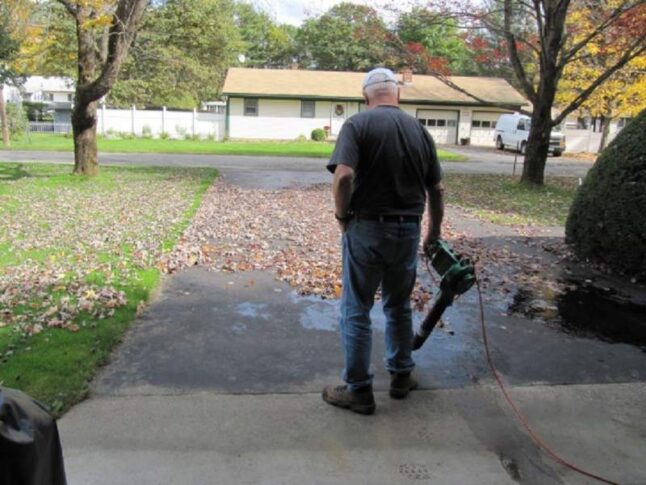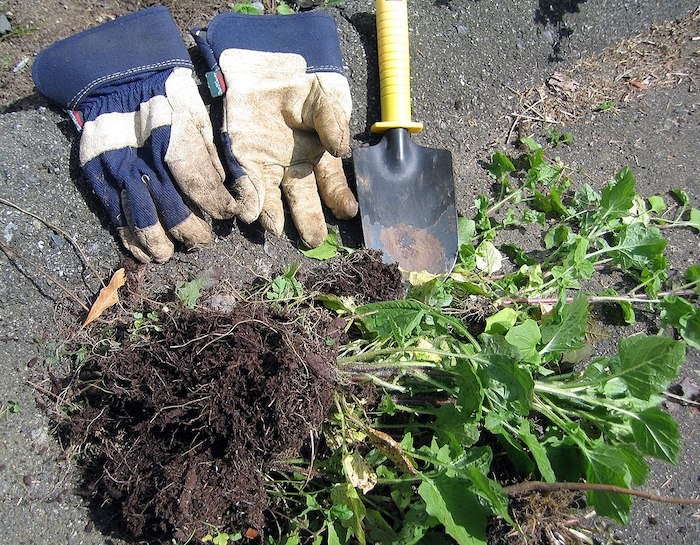
While the winds of fall bring exciting changes, they also mean it’s time to start thinking about leaf removal. Whether you’re all aboard the DIY train or need some help, leaf removal in Orlando can be a breeze with the right approach.
Let’s take a closer look at why leaf removal is essential, some top tips and tricks, essential tools you’ll need, and more.
In this article:
9 Tips for Leaf Removal in Orlando
Leaves not only look less than appealing in your yard, but they can also be detrimental to the health of your turf. Leaves block the sunlight and crucial nutrients needed for photosynthesis, resulting in a lawn that is anything but healthy.
A good seasonal leaf removal helps the grass “breathe,” getting the necessary sunlight and energy it needs – regardless of what type of grass you’ve got growing in your yard.
Here are some helpful tips to give you the upper hand when it comes to leaf removal in Orlando, FL.
1. Get Ahead of the Problem

It’s so much easier (and much less work!) to remove leaves before they become a huge issue. Set aside some time during the early fall months to tackle the leaves before they pile up too much, and you’ll save yourself a lot of time and trouble in the future.
2. The Right Tool Makes All the Difference

Raking is usually the go-to method for leaf removal, but it can be pretty backbreaking work. Use an extra-wide rake with thin prongs, and make sure you don’t twist your body or jerk it unnaturally during the process.
If you’d like to try something easier, consider investing in a leaf blower or yard vacuum – but keep in mind that these can be pricey.
Here are a few additional things to bear in mind when it comes to leaf removal tools:
- If you’re opting for the blower route, choose an electric model instead of one powered by gas. Not only will this be better for your wallet, but it’s also eco-friendly and easier on your lawn.
- Leaf tarps are extremely helpful in simplifying the process and making clean-up a breeze – once the leaves have been gathered, you can easily fold the tarp up with the mess inside and carry the whole thing away.
- If there aren’t too many leaves on your lawn, you don’t need to bother with removal – you can mulch the leaves with a mulching lawn mower instead.
3. Weed Your Yard Prior To Removing Leaves

Removing leaves first and dealing with the weeds later might seem to make sense – but in reality, it’s totally backward! Weeds tend to love living under damp leaf piles, so slaying them is the key to success when your priority is healthy grass.
Pull out the weeds first, then remove all of the dirt-hugging leaves. In doing so, you’ll prevent any weed spores from re-germinating. A good weed control program helps to ensure a healthy and beautiful lawn.
4. Diseases: Beware

Leaving rotting leaves on your lawn can create a haven for mold and fungal lawn diseases. Removing those leaves promptly can help prevent fall and winter lawn diseases.
Orlando’s humid climate creates an ideal breeding ground for fungus, so you should keep your eyes peeled for signs of disease, such as thinning or discolored grass, while you’re removing leaves.
5. Pests: Remove That Unwanted Tenant From Your Lawn

Leaves are a breeding ground for pests. A large pile of leaves not only serves as an especially inviting home to unwelcome critters, but it also gives them plenty of fertile soil in which to dig tunnels and lay eggs.
The most common Orlando area pests are usually rodents, palmetto bugs, roaches, and more. To avoid rental agreements with these critters, you’d be wise to ensure your yard is pest-free before the first cold snap – and removing leaves is the first step.
6. Water Studies: Don’t Let The Faucets Run

In Florida, water conservation is especially important. Leaves on the lawn can cause issues when it comes to proper drainage and water usage. They’re hydrophilic and easily absorb water, which can lead to a lot of wasted landscape irrigation water.
To prevent excess water use, remove the leaves ASAP and follow water-conserving practices whenever possible. Follow these tips for watering your Orlando lawn to ensure your grass gets plenty of water but not too much.
7. Wet Leaves Need Love, Too

If you use a leaf blower or something similar to get rid of dry leaves, don’t forget about the leftover wet leaves. A rake will be necessary to remove the soggy debris.
While it might be tempting to ignore such a tiresome chore – don’t! Wet leaves will almost certainly cause lawn diseases and/or attract pests if they’re left to fester, so don’t let them linger.
8. Don’t Sweat It If You Don’t Have Many Leaves

If your yard only has scattered leaves, you can often leave them (just make sure to mulch them) or use a lawn mower to gather them in bags. Taking the manual labor out of leaf removal means you can still make sure your lawn is getting the TLC it needs without a lot of extra effort. Win!
9. Curb Appeal: Keep That Lawn Magazine-Ready

Ah, the beauty of a well-manicured lawn! Everyone wants their property to look like it’s just stepped out of the pages of Home & Garden magazine, and leaf removal is an essential step for achieving that well-maintained feel. A tidy lawn is essential for curb appeal, especially if you’re in the process of selling your home.
Remember, first impressions are everything!
Tools for Leaf Removal
Tackling leaf removal can be a lot easier when you have the right set of tools for the job. Here are some of the best:
• A good-old-fashioned leaf rake: $10-20 – A bit boring but effective; perfect for when you’re working on a tight budget.
• Leaf tarp: $20-30 – If you’re looking for something to make manually collecting leaves a breeze, this is it.
• Leaf blower: $200-300 – Make leaf removal easier and quicker than ever.
• Yard vacuum: Between $400-700 – You already have a vacuum inside the house, why not get one for outside as well? This tool is perfect if you’re looking to shred and bag leaves in an instant.
FAQ About Leaf Removal in Orlando
Don’t wait too long. It’s not recommended that you let leaves sit on the grass for more than three or four days.
You might have to adjust this according to inclement weather, the number of trees in your yard, and the severity of the seasonal leaf drop. The key is to get a little bit done at a time so you don’t fall too far behind.
The type of rake matters – avoid narrow rakes with fan spreads of less than 30 inches. Instead, go for one with angled tines specially designed to resist piercing leaves. This will make the task much quicker and easier.
If the volume of leaves on your lawn is overwhelming, a mulching mower might be the answer. Just ensure that the grass is still visible and standing vertically after it’s been cut. If not, redistribute the extra mulch with either a rake or leaf blower.
Whether it’s for leaf removal or anything else, the cost really depends on which services you choose and how often.
On average, homeowners pay anywhere from $29 to $65 per visit for lawn care. Mowing services will typically range from $29 to $65, while yard clean-up services (which include leaf removal) often cost between $170.50 and $374.30 per visit.
Without a doubt! Central Florida offers an ideal climate for diseases and pests, which is why lawn maintenance should be a top priority. From tree trimming and lawn mowing to fertilization and aeration, there’s a lot you can do (or hire someone to do) to keep your landscape looking perfect.
Yes, it most certainly does! A well-maintained lawn is a sign of respect and can add to the value of your home.
Plus, a clean yard always looks better than one covered in leaves or debris. No matter how much you love your fall foliage, it doesn’t do any good when it’s cluttering up the place.
Hire a Lawn Care Professional Today
A bit of DIY work can be great for some, but if manual labor isn’t your cup of tea, consider hiring an Orlando lawn care professional to remove leaves for you. Sure, it may be more expensive, but it can be well worth the cost.
Not only can a lawn care pro help you save time and energy, but more importantly, they have professional-grade tools that will get the job done quickly and efficiently.
Either way, with a bit of thought and effort – plus the right tools, of course – you’re sure to have a pristine fall lawn in no time.
Main Photo Credit: Rosapicci / Wikimedia Commons / CC BY-SA 4.0





